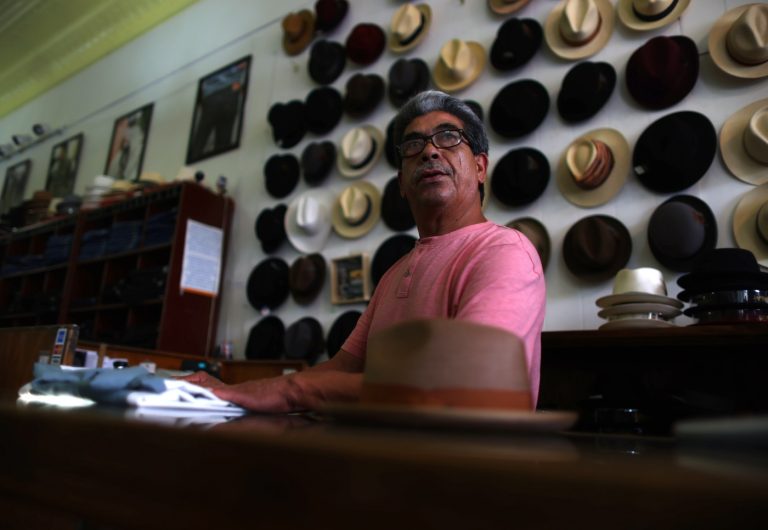Kelly Thompson lives in a sun-faded camper at an encampment in an industrial corner of West Oakland. At 76, being homeless is getting harder. Thompson is feeling it in his bones.
“My knees are hurting. My hips are hurting. My feet hurt. It hurts all over,” he said.
According to a new UC San Francisco study, nearly half of California’s rapidly aging homeless population is now over the age of 50. And amid a severe affordable housing shortage, that trend is expected to continue.
By 50, a homeless person’s health more closely resembles that of someone in their 70s, with a higher chance of chronic disease, mobility issues and cognitive decline, according to the study. Researchers say understanding the challenges of caring for such a vulnerable population is crucial to stemming the crisis.
“This has just huge implications for service providers, for policymakers — really for all of us to recognize that increasingly when we talk about homelessness, we’re talking about homelessness for older adults,” said Dr. Margot Kushel, director of UCSF’s Benioff Homelessness and Housing Initiative.
California’s general population is also aging. State officials project that by 2040, nearly one in every four residents will be 65 or older, underling the urgency of addressing the root causes of older adult homelessness.
In Thompson’s case, outreach workers are trying to secure a housing voucher for him, but for now, he prefers what he described as the freedom of living out of his vehicle near Interstate 880.
Besides, Thompson explained as he fashioned a wooden shelf on a makeshift workbench outside his RV, without getting help paying rent, he has little choice.
“I have a hard enough time finding a way to buy groceries, to pay my phone bill,” he said.
Thompson, who was raised in Texas, came to the Bay Area in 1990 for a job as an electrician. After work dried up during the Great Recession, Thompson — like the 41% of older homeless people who first lost their housing after age 50 — moved into his minivan in 2012.
Aside from the constant worry of having his vehicle towed, Thompson rejects the idea that living at the encampment is a hard life. Still, he acknowledged he could soon be ready to move into a lasting home.
“There will be a time, and it feels like it’s close by,” he said in a soft Texas drawl.
The UCSF study, based on a survey released last year of 3,200 homeless residents statewide, found that 81% of older homeless people had experienced mental health issues, 79% had been incarcerated, 67% had been a victim of violence, and 64% had used drugs at some point in their lives.
While those factors contribute to homelessness among older people, researchers and service providers said high housing costs and low incomes are the main reasons they lose their housing.
“I would really point to income disparity as the common thread among the aging adults we serve,” said Kelly Vazquez, chief program officer with HomeFirst, a nonprofit that supports homeless people in the South Bay.
According to the UCSF survey, the typical monthly income for older unhoused people in California was $920 during the six months before they became homeless. Compare that to the statewide median rent for an available studio apartments of $1,656, according to Zillow.
Two-thirds of respondents said just an extra $300 to $500 a month would have prevented them from becoming homeless. And 89% said a permanent rental subsidy or voucher would have kept them housed.
Older people can be at higher risk of homelessness because they’ve often stopped working and are living on a fixed income, Vazquez said. HomeFirst works to connect aging homeless people with social security and other benefits and helps them sign up for affordable housing waitlists and vouchers.
Kelly Thompson ,76, moves a saw at a work area near his trailer on Thursday, May 30, 2024, in Oakland, Calif. California’s homeless population is aging fast, with nearly half of all unhoused adults now over the age of 50, according to a new study from UC San Francisco. (Aric Crabb/Bay Area News Group)
Related Articles
Measure to slow development in Silicon Valley commuter county qualifies for ballot
Median home price surpasses $2 million in these two Bay Area counties
Homelessness in San Mateo County jumps 18% even as more people get shelter beds
One San Jose tiny home shelter is successfully moving people to housing. Can it be a model for other sites?
Letters: Housing rules | Health care access | Gas prices | Vote Democrat
Researchers also found that homeless people over 50 stayed homeless for 25 months on average, compared to 20 months for those who are younger.
Kushel with UCSF said the disparity reveals the state’s efforts to combat homelessness often overlook the needs of older unhoused residents. Homeless people in the survey described barriers to moving into a shelter or supportive housing, such as a lack of elevators, shower handrails, or wheelchair ramps, she said. Some said they had to turn down an offer of shelter when the only available bed was a top bunk.
The study, which was released May 23, recommends working to remove those obstacles and tailoring services and programs to the needs of older people, much like providers do for those with behavioral issues.
Researchers also said policymakers must find a way to build more affordable housing for the state’s very poorest residents and expand housing vouchers and other rental assistance, while also boosting mental health and addiction services.
Kushel added that service providers and agencies must do more to identify older people on the edge of homelessness — for example, someone at risk of losing their state-subsidized income as an in-home caregiver once a parent dies — and prioritize them for financial aid and other support.
“We have a real moral imperative, but also a real opportunity,” she said. “We could meaningfully reduce the number of people experiencing homelessness if we focused on this group.”








